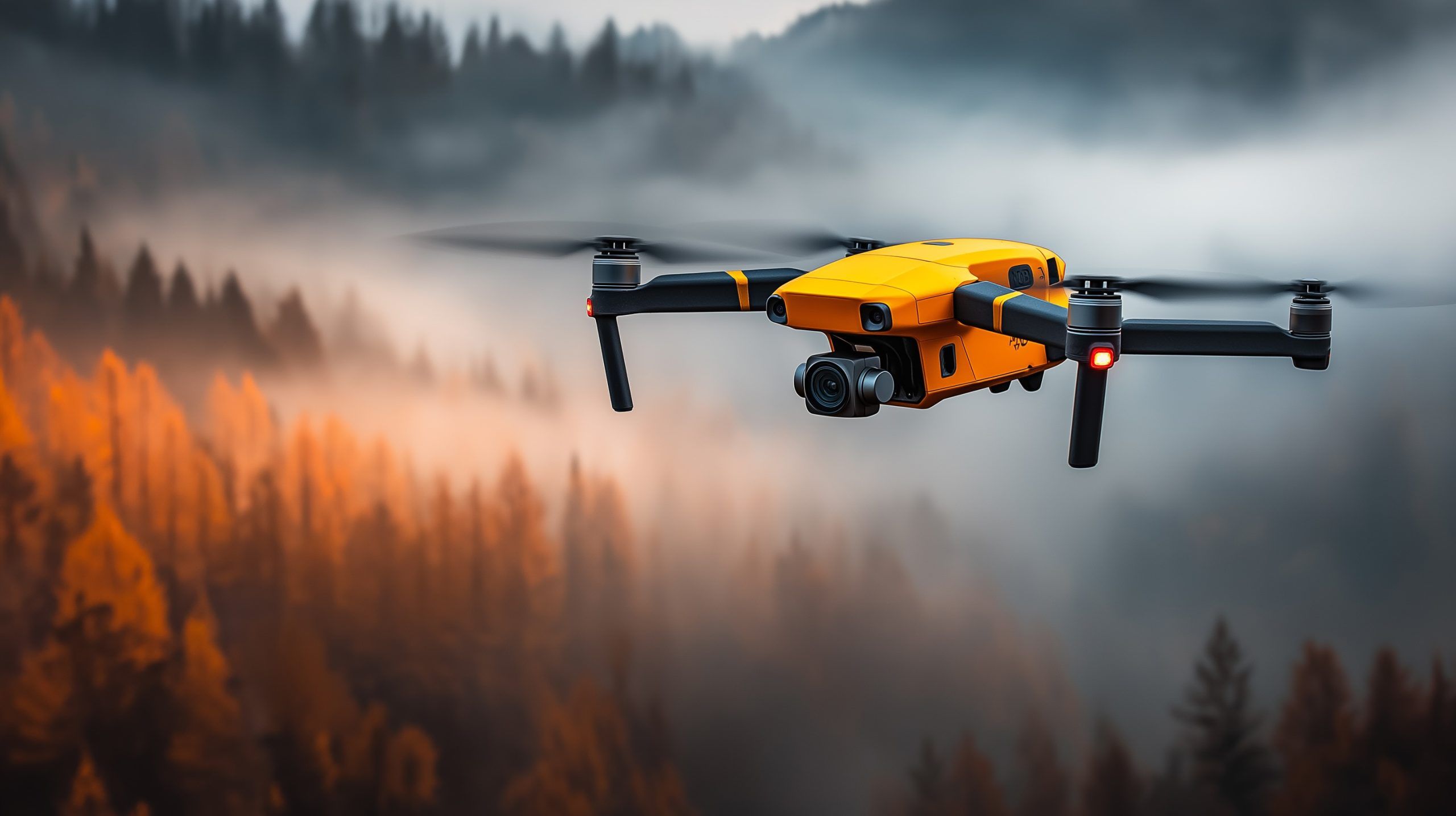- In Q3 2025 the global drone market faces significant supply-chain pressure from component shortages, tariffs, and logistics delays, with China historically dominating motor, ESC, battery, flight controller, camera, sensor, propeller, and carbon-fiber airframe production.
- After China tightened dual-use drone component exports in late 2024, infrared sensor exports fell by 30% and prices tripled, while U.S.-bound component volume dropped 60% and high-end infrared modules rose from $400–$500 to over $1,500.
- In April 2025 the United States imposed a 125% tariff on Chinese drone imports, pushing total import taxes to about 170% and lifting prices roughly 2.7x for many Chinese-made drones and parts.
- DJI has been on the U.S. Entity List since 2021, and UFLPA enforcement has led to DJI shipments being detained at U.S. ports.
- Global logistics delays persist in 2025, with shipments held for extra inspections under human-rights rules and lead times stretching from one week to several weeks, while China’s port controls add to overseas delays.
- To mitigate risk and costs, brands are shifting assembly to Vietnam, India, or Mexico and investing in local U.S./EU production, signaling a push toward supply-chain sovereignty.
- U.S.–China tech tensions are driving decoupling in the drone supply chain, with the Commerce Department floating new rules to secure the UAS supply chain that could prohibit drones or components from foreign adversaries.
- Global military UAV spending in 2025 reaches about $8.2B, led by the U.S. with roughly $1.9B and a $350M Pentagon Replicator program, while India spends $534M and Poland leases MQ-9A Reapers before buying MQ-9B by 2024, with Ukraine leveraging civilian drones for ISR and improvised roles.
- The EU, India, and China articulate national drone strategies: the EU through the EDF and PESCO to fund joint drone projects, India via Make in India, and China targeting 10% of deliveries by drones within 5–10 years and a domestic market above ¥3.5 trillion by 2035.
- New export-control regimes in 2025 include the US easing MTCR-related limits for certain Category I UAS exports to allies via a January 2025 National Security Memorandum, the EU tightening arms export controls and drone-specific sanctions, China adding drone exports to its controls in 2023–2024, and the Wassenaar Arrangement updating its dual-use list to cover drone software and counter-drone systems.
Introduction: The global drone industry in the third quarter of 2025 is navigating a complex landscape shaped by post-pandemic supply chain strains, rising geopolitical frictions, and evolving regulatory regimes. Drones have become indispensable across consumer, commercial, and military sectors, but demand growth is colliding with disruptions in component supply and trade. Meanwhile, international tensions – especially between the U.S. and China – are prompting shifts in manufacturing strategies and government policies. This report provides a detailed analysis of how supply chain pressures are impacting drone manufacturers and pricing, how geopolitical factors (from U.S.–China tech rivalry to military procurement surges) are influencing market trends, and what new export control measures in the U.S., EU, and other jurisdictions mean for the industry’s future. All major drone segments – consumer, enterprise commercial, and military – are examined with up-to-date developments and expert insights.
Supply Chain Pressures in Q3 2025
The drone supply chain is under significant pressure in 2025, as manufacturers face disruptions ranging from critical component shortages to tariff-induced cost spikes. Chinese manufacturers have long dominated production of key drone parts – motors, electronic speed controllers (ESCs), lithium batteries, flight controllers, cameras, sensors, propellers, and carbon-fiber airframes – making China the backbone of the global drone supply chain [1]. This dominance brought efficiency and low costs, but it has also created a single-point vulnerability. Escalating trade barriers and export restrictions are now exposing how heavily Western drone makers rely on China, leading to higher costs and delayed production for drones across all segments [2] [3].
- Component Shortages and Price Spikes: New export controls imposed by China on dual-use drone components have led to acute shortages and soaring prices for critical parts. For example, after Beijing tightened permit requirements on advanced drone technologies in late 2024, exports of infrared sensors (used for drone night vision) plummeted by 30%, and their prices tripled [4]. U.S.-bound supply of these components fell sharply (60% volume drop), causing per-unit prices to surge 3.5× for American buyers [5]. Industry analysts note that a high-end infrared module which cost $400–$500 before now exceeds $1,500 [6]. Such spikes are straining drone manufacturers and operators who had depended on affordable Chinese parts. As one aerospace engineer warned, missing even a single piece of the supply puzzle “renders the system dysfunctional,” a reality now hitting the drone sector [7]. These component bottlenecks are forcing companies to delay product rollouts and driving up costs for end users, with some enterprise drone models likely to see retail price hikes as a result [8].
- Tariffs and Trade Barriers: Geopolitical trade disputes have injected further volatility into the supply chain. In April 2025, the U.S. dramatically escalated tariffs on Chinese drone imports, piling on a 125% reciprocal duty that brought total import taxes to about 170% for most Chinese-made drones and parts [9] [10]. This “tariff shock” sent financial shockwaves through the industry, as importers suddenly faced pricing that is nearly 2.7× higher than before [11] [12]. Even U.S. drone distributors reported immediate notifications that major Chinese drone lines would see price increases due to the tariffs [13]. Many retailers initially tried to shield consumers by selling off pre-tariff inventory, but once those stocks exhausted, drone prices in the U.S. began climbing sharply [14]. Hobbyist and professional users alike are now bracing for higher costs on everything from popular camera drones to batteries and spare parts. Importers have little choice but to pass on the 170% duty in pricing, especially for high-value enterprise drones, fundamentally “reshaping pricing across the entire supply chain” [15]. The tariff war has thus turned drone procurement into a “high-stakes challenge”, where miscalculating import costs can wipe out profit margins [16]. Notably, the U.S. had added the market-leading drone maker DJI to its Entity List back in 2021, restricting its access to U.S. technology [17]. This, combined with customs enforcement of the Uyghur Forced Labor Prevention Act (UFLPA) – which has led to DJI shipments being detained at U.S. ports – means some Chinese drone products face both regulatory holdups and punitive tariffs entering Western markets [18] [19]. These trade barriers inject uncertainty and cost at every step of the supply chain.
- Logistics Delays and Bottlenecks: Global logistics woes, though easing from pandemic peaks, continue to affect drone supply lines in 2025. Shipping delays and heightened customs scrutiny are extending lead times for key components. As noted, some DJI drone shipments have been held up by U.S. Customs for additional inspections (under human-rights import rules), leading to temporary stock shortages for certain models [20]. Manufacturers are also reporting that what once took one week to ship can now take several weeks due to backlogs, straining just-in-time production schedules (especially for smaller drone startups that lack large inventories). Additionally, China’s own port controls on sensitive technology exports add another layer of delay for overseas buyers [21]. These logistical frictions mean drone makers must plan further ahead and hold larger inventory buffers, tying up capital and potentially raising prices. Labor shortages in manufacturing and freight are also a factor: industry surveys indicate persistent labor gaps in electronics assembly and transport, contributing to slower turnaround. While not unique to drones, these issues compound the supply chain challenges at a time of surging demand.
Impact on Manufacturers and Pricing: The convergence of component scarcities, tariffs, and shipping delays is squeezing manufacturers’ margins and complicating pricing strategies. Drone companies in North America and Europe find themselves paying more for raw materials (from semiconductors to batteries) and scrambling for alternative suppliers when Chinese sources are restricted [22] [23]. Some U.S. manufacturers initially hoped the tariffs on Chinese goods would make their own drones more price-competitive, but many still rely on Chinese-made inputs – like motors, gimbals, and rare-earth magnets – so they are absorbing higher input costs instead of gaining an edge [24]. China’s retaliatory measures have included export controls on critical minerals (e.g. rare earth elements like samarium and gadolinium) vital for drone electronics [25]. This has driven up costs for components such as magnets, batteries, and imaging systems, offsetting any benefit U.S. firms might have gotten from tariffs on finished drones [26] [27]. As a result, both Chinese and Western drone makers are raising prices or delaying deliveries. A U.S. drone reseller described the situation bluntly: “confusion has reached an all-time high… any pricing standards are out the window” due to the rapid tariff and supply changes [28]. Many enterprise customers are now rethinking procurement – some stretching the life of their current drone fleets, others considering refurbished or second-hand units if new models become too costly [29] [30]. On the consumer side, higher prices on popular hobby drones may price out entry-level users, dampening unit sales even as demand remains robust. Overall, the supply chain pressures of Q3 2025 are forcing the industry to prioritize resiliency: manufacturers are diversifying suppliers and relocating production where possible, even at higher cost [31] [32]. For example, some drone brands have shifted assembly to Vietnam, India, or Mexico to bypass Chinese tariffs, and others are investing in local U.S./EU production despite the time and expense required [33] [34]. These moves echo a broader push for “supply chain sovereignty” – reducing dependence on one country – but as history shows, building a self-sufficient drone supply chain is a long-term endeavor [35]. In the interim, manufacturers and consumers must contend with a costlier, less predictable market shaped more by geopolitics than by normal market forces [36] [37].
Geopolitical Influences on the Drone Market
Geopolitics are profoundly influencing the drone market in 2025. From superpower tech disputes to regional conflicts, political factors are reshaping both the demand and supply sides of the industry. Key geopolitical factors affecting the drone sector include:
- U.S.–China Tech Tensions: The rivalry between the United States and China is playing out vividly in the drone industry, given China’s dominant position in drone manufacturing. Washington has increasingly viewed Chinese drones as a national security risk, responding with measures to curtail their use and entry into sensitive markets. Since 2019, U.S. authorities have taken steps to blacklist leading Chinese drone firms and ban federal agencies from using certain Chinese-made drones on security grounds [38]. By 2025, under a new administration, these efforts intensified: the U.S. not only imposed steep tariffs on Chinese drones (as noted) but also moved to restrict technological ties. The Department of Commerce in early 2025 floated new rules to “secure the UAS supply chain” by potentially prohibiting drones or components made by foreign adversaries [39] [40]. Such policies would effectively bar many Chinese-origin drones and parts from U.S. critical infrastructure and government contracts, forcing a shift to vetted domestic or allied suppliers [41] [42]. The motivation is to prevent data leaks or cyber vulnerabilities in drones used for everything from law enforcement to energy inspections [43]. China, for its part, has reacted strongly. Beijing added several U.S. firms to its “unreliable entities” list in April 2025 and tightened its own export controls on drone technologies in response to U.S. pressure [44]. Chinese officials also announced export licensing for certain high-performance drones and related equipment, officially to “safeguard national security” [45] [46]. Unofficially, these moves can serve as leverage in the broader tech standoff – reminding the West that China can withhold or raise the cost of critical drone inputs. The tit-for-tat dynamic has left manufacturers in the crossfire: sourcing “sanction-free” components is increasingly complex as more parts become entangled in entity lists and export license requirements [47]. Notably, Chinese drone makers like DJI, who hold an estimated 75% of the U.S. consumer drone market, have found themselves squeezed out of public-sector sales in the U.S. [48]. They also face hurdles in some European markets where governments are adding Chinese suppliers to security blacklists [49]. In China, officials are doubling down on domestic demand to compensate, rolling out initiatives to grow the “low-altitude economy” (a term for the drone and urban air mobility sector) into a multitrillion-yuan market by 2035 [50] [51]. In short, the U.S.–China strategic competition is fragmenting the once-global drone supply chain: Western companies are searching for non-Chinese components, Chinese companies are looking inward or to emerging markets, and industry players worldwide must navigate export bans and compliance risks at every turn.
- Military Conflict and Defense Drone Demand: Geopolitical flashpoints and conflicts are also driving unprecedented military demand for drones, altering procurement trends globally. Drones have proven their battlefield value in recent wars – most prominently in Ukraine, where both reconnaissance quadcopters and armed drones have been used extensively. In fact, drones have caused more casualties in Ukraine “than any other weapon,” underscoring their decisive role in modern warfare [52]. The Ukraine war has galvanized NATO and Western allies to pour resources into drone systems: by late 2024, over £1 billion (~$1.2B) had been committed by international coalitions to provide drones and loitering munitions to Ukraine [53]. This urgency to support Ukraine (and to study the conflict’s lessons) has accelerated military drone programs across Europe [54]. For example, Poland fast-tracked the acquisition of U.S.-made MQ-9 Reaper drones – leasing MQ-9A Reapers as a bridge before buying the latest MQ-9B – a deal realized by the end of 2024 [55]. Such procurements show a clear trend: countries are no longer hesitant to invest in high-end unmanned aerial vehicles (UAVs) for intelligence, surveillance, and reconnaissance (ISR) and strike roles. Simultaneously, the conflict spurred innovation in low-cost drones: Ukraine’s military and volunteer units famously repurposed hundreds of civilian and commercial drones (like DJI quadcopters) as improvised scouts and even as bomb carriers [56]. This blurring of consumer and military drone use highlights the rising demand for “dual-use” platforms – systems that can be adapted from civilian models for military purposes. It also revealed a tactical shift: small, expendable drones can have outsized impact, prompting armed forces to seek swarms of cheaper UAVs rather than a few exquisite ones. Globally, defense budgets are responding. In 2025, global spending on military UAVs is estimated at $8.2 billion, a record high [57]. The United States leads with roughly $1.9B of that (nearly 24% of global UAV outlays) [58], funding projects such as the Pentagon’s Replicator initiative (allocated $350M) which aims to deploy “thousands of attritable autonomous systems” within a year [59]. The Replicator program exemplifies the new priority on quantity over cost: the U.S. is investing in swarms of low-cost drones (including disposable first-person-view drones and unmanned “loyal wingman” aircraft to assist fighters) to counter adversaries like China [60] [61]. Other major powers are following suit – India, now the third-largest UAV spender at $534M in 2025, is acquiring 31 MQ-9B SeaGuardian drones and also nurturing indigenous UAV startups [62]. In the Middle East, countries such as the UAE are resuming drone purchases (e.g. 18 MQ-9B drones) after earlier deals were paused [63]. The net effect is a global drone arms buildup: militaries large and small are integrating unmanned systems for reconnaissance, strike, and logistic support roles at unprecedented rates. This drives the market for military drone manufacturers, but also raises the stakes for supply chains – as these defense drones require advanced sensors, secure data links, and often remain subject to export controls (requiring government approvals for international sales). Geopolitical conflict thus boosts demand but also invites greater government oversight on who can buy cutting-edge drones.
- National Drone Development Strategies: In response to security concerns and supply vulnerabilities, many nations are crafting strategies to build up their domestic drone industries. The European Union, for example, has explicitly prioritized drone technology as part of its defense and industrial policy. Through funding mechanisms like the European Defence Fund (EDF) and coordinated projects under Permanent Structured Cooperation (PESCO), the EU is investing heavily in drone development, innovation, and manufacturing capacity [64]. EU leaders have committed to strengthen Europe’s own drone producers and reduce “strategic dependencies” on foreign suppliers [65] [66]. This involves supporting joint R&D (for instance, a European MALE drone program led by companies in France, Germany, Italy, and Spain) and improving interoperability among member states’ unmanned systems. The European Defence Agency has also launched an innovation hub focused on advancing UAS technology through collaborative projects [67]. A notable policy initiative is the proposed “EU drone package” – aimed at stimulating joint procurement among member states and boosting participation of European industry (including Ukrainian drone tech firms) in the supply chain [68]. Similarly, countries like India have instituted “Make in India” policies encouraging local production of drones for both civilian and military use. India banned the import of ready-made foreign drones in 2022 (while allowing import of parts) and set up incentive schemes for domestic manufacturers, leading to a surge of Indian drone startups. By 2025, India’s strategy is yielding results: indigenous companies are producing agriculture and surveillance drones, and joint ventures are being forged to manufacture advanced drones (like kamikaze drones or UAV swarms) domestically for the Indian armed forces [69] [70]. China, which already leads the world in drone output, has its own development strategy centered on what it calls the low-altitude economy. Beijing views drones (and related technologies like urban air mobility) as a pillar of future economic growth and technological prowess. Government plans set ambitious targets – for instance, 10% of all deliveries in China to be done by drones within 5–10 years, and a domestic drone market exceeding ¥3.5 trillion (~$500B) by 2035 [71] [72]. To achieve this, China is funneling state support into drone companies, investing in next-gen technologies (AI pilots, swarm networking, high-endurance power systems), and aggressively securing intellectual property [73] [74]. Chinese drone firms also benefit from a large home market: from drone delivery services in Shenzhen to aerial agriculture programs in Guangxi, domestic deployment is scaling rapidly under supportive regulations [75] [76]. This not only strengthens Chinese companies financially but also allows them to iterate technology faster. The United States, recognizing the security imperative, has launched its own initiatives to spur domestic drone innovation – particularly for small unmanned systems. The Pentagon’s Blue UAS program is one example: it curates a list of trusted, U.S.-made (or allied-made) drone components and products that are approved for government use [77]. This framework, born from the 2019 American Security Drone Act and subsequent defense authorization acts, has funneled business toward U.S. drone makers like Skydio, Teal, and others that meet stringent supply chain and cybersecurity criteria [78] [79]. While U.S. companies still face challenges scaling up production, they have seen a boost in government contracts as federal agencies seek NDAA-compliant (non-Chinese) drones. Additionally, the U.S. military’s investments in cutting-edge UAV programs – such as the Air Force’s Collaborative Combat Aircraft (loyal wingman drones to fly alongside manned jets) – indicate a strategic push to remain ahead in drone technology [80] [81]. In summary, national strategies across the globe are converging on a similar goal: build more self-reliance in drone capabilities. Whether it’s the EU funding joint drone projects, China elevating drones to a strategic industry, or the U.S. and allies seeking secure supply chains, these efforts all respond to the geopolitical climate. They herald a future in which the drone market may be more regionally segmented (with distinct Chinese, American, and European ecosystems) but also one where innovation is spurred by healthy competition and significant state investment.
New Export Controls and Policy Shifts Regulating Drones
Recent legislative and policy shifts around the world are creating new export controls and regulations on drone technology. Governments are tightening oversight on who can trade, receive, or use advanced drones and their components – often linking these controls to national security or foreign policy concerns. Below is an overview of major export control developments in the U.S., EU, and other key jurisdictions:
- United States: In the U.S., export control policy for drones has seen two seemingly opposite trends: restricting adversaries’ access to American drone tech, while loosening constraints on exports to allies. On one hand, Washington has continued to expand controls under its export laws (like the Export Administration Regulations and International Traffic in Arms Regulations) to deny drone-related technology to hostile states such as Iran, Russia, and China. U.S. authorities have aggressively enforced sanctions on illicit drone supply networks – for example, indicting individuals smuggling American drone parts to Iran or Russia in violation of export bans. At the same time, the Biden administration enacted a significant reform in January 2025 by easing some Cold War-era missile technology controls that had severely limited U.S. drone exports even to friendly nations. In one of President Biden’s final acts, a National Security Memorandum was issued loosening export controls on Category I unmanned aerial vehicles (long-range, high-payload drones) for “certain U.S. partners with strong export control systems.” [82]. This new guidance under the Missile Technology Control Regime (MTCR) essentially allows the U.S. to more readily export large military drones (and related missile tech) to allies, aligning policy with the reality that competitors like China and Israel freely sell UAVs on the global market. The aim, as stated, was to “strengthen allied defense capabilities” and bolster the U.S. defense industrial base by streamlining drone sales abroad [83]. In practical terms, this means countries such as certain Middle Eastern, NATO, or Indo-Pacific partners could more easily buy American systems like the MQ-9B SkyGuardian, whereas previously they might have been blocked by strict MTCR rules. (Notably, a prior loosening under the Trump administration in 2020 had already reclassified some drones to enable exports [84], and Biden’s move further builds on that.) Concurrently, U.S. export restrictions have tightened against malign actors: the U.S. has banned exports of drone parts to Russia and Belarus since 2022 (with harsh penalties for violators), and it continues to sanction Chinese companies linked to military UAV proliferation. The federal government is also exploring adding certain drone technologies to its Commerce Control List of dual-use items, which would require special licenses for export to any country of concern [85] [86]. In sum, U.S. policy is becoming more discriminating – facilitating drone tech sharing with allies while cutting off adversaries – reflecting an effort to maintain a competitive edge without undermining non-proliferation goals.
- European Union: The EU has likewise updated its export control stance in light of geopolitical developments. In April 2025, the Council of the EU adopted a decision to strengthen the Common Position on arms export controls, emphasizing responsible trade and preventing diversion of military technology [87] [88]. Although this framework is broad (covering all military equipment), drones are a key concern given their dual-use nature. EU member states agreed to maintain “high common standards” for arms exports and to improve information-sharing on export denials and end-user monitoring [89]. A driving factor in this review was the need to support Ukraine while ensuring European weapons don’t end up with unauthorized users [90]. Concretely, the EU has already implemented drone-specific sanctions in recent years. Since July 2023, the EU established an export ban on drone components to Iran, directly targeting the supply chain that Iran used to build Shahed kamikaze drones supplied to Russia [91] [92]. This ban covers key parts like engines and electronics that could be used in UAVs, seeking to choke off Iran’s drone program given its involvement in Russia’s aggression in Ukraine. The EU has also added numerous Iranian and Russian drone manufacturers to its sanctions lists (asset freezes and trade bans) to prevent European companies from aiding those entities [93] [94]. More broadly, the EU’s Dual-Use Regulation was updated (effective September 2021) to tighten controls on emerging technologies, which can include certain drones or related software if they have military applications [95]. For instance, high-end imaging sensors or encryption in drones might require an export license if being sent outside the EU. As EU nations collaborate on new drone projects, they are also working on facilitating intra-EU technology transfers so that co-developed drones can be exported more easily to partner countries without bureaucratic hurdles [96] [97]. However, any such exports will be measured against the strengthened criteria to ensure they don’t fuel conflict or repression. The European Parliament, for its part, has called for “robust export controls” on drones and related tech, especially regarding autonomous weapons – urging that EU-made drone tech not contribute to human rights abuses or destabilization [98] [99]. The net effect is that Europe is becoming more unified in its export control approach: making sure Europe’s burgeoning drone industry can export jointly-developed systems (e.g., to friendly countries or UN missions) while clamping down on exports to rogue states or conflict zones.
- China and Other Jurisdictions: China has introduced its own new export controls on drones, both for strategic and political reasons. Citing national security (and likely in response to U.S. restrictions), Beijing announced in mid-2023 that it would limit exports of certain high-performance civilian drones and related components [100]. The rules, which took effect in 2023–2024, require Chinese firms to obtain government licenses before exporting drones that meet particular criteria – for example, drones with long flight ranges, heavy payload capacity, or the ability to operate autonomously. Officially, China said it wanted to prevent drones from being used in warfare in Ukraine, stating that civilian drones not covered by the new controls “are prohibited from export for military purposes” [101] [102]. In practice, these curbs have indeed disrupted drone supplies to Russia, which had been buying large numbers of Chinese hobby drones for use on the battlefield [103] [104]. Chinese manufacturers grew wary of violating the rules, causing some to halt or alter sales to Russian clients. Beyond the Ukraine context, China’s export control law (updated in 2020) now explicitly covers drones and related software as sensitive items, allowing Beijing to restrict exports to any country or end-user it deems a risk. Notably, in mid-2024 China added drone-related technologies (like certain lidar systems and thermal imaging cameras) to its export control list, which led to the supply crunch in infrared sensors noted earlier [105] [106]. This was perceived in part as retaliation to U.S. semiconductor bans – China leveraging its dominance in niche drone tech as a bargaining chip. Other major jurisdictions have also refined drone export policies. Russia, under heavy sanctions, has resorted to importing commercial drones through third countries and developing its own production, but Russian high-tech drone exports are negligible due to sanctions. Turkey, a rising drone exporter (with its Bayraktar TB2 drone made famous in conflicts), has to navigate MTCR guidelines but generally treats drones as exportable defense articles with government approval; Turkey has sold drones to many countries but reportedly held off some sales under Western pressure. Israel, historically a top drone exporter, continues to use case-by-case government licensing, recently tightening oversight to ensure its drone sales (like the Heron TP or Harop) do not upset key alliances (e.g., limiting sales to China after U.S. objections). Global regimes are also adapting: the Wassenaar Arrangement (a 42-nation export control regime) has updated its dual-use control list to include certain drone software and counter-drone systems, indicating a multilateral effort to monitor drone tech flows. Overall, export controls in 2025 reflect a balancing act – nations seek to guard advanced drone technology from foes and prevent proliferation (especially to conflict zones or terrorist groups), yet they also want to promote their domestic industries’ growth through exports where safe. The evolving regulations from the U.S., EU, China, and others underscore that drones are now viewed as strategic goods. For drone manufacturers and international buyers, this means greater compliance hurdles: sales might require government approvals, and some cutting-edge components might simply be off-limits to import or export depending on the destination. Policy analysts note that we are likely entering an era of more “techno-nationalism” in drones, where export control regimes play a major role in shaping who leads the market and who has access to the latest capabilities [107].
Conclusion
By Q3 2025, the global drone market has become a microcosm of broader economic and geopolitical currents. Supply chain pressures – from electronics shortages to tariff shocks – are forcing drone makers to rethink sourcing and pricing, even as demand for drones keeps climbing. Geopolitical influences are omnipresent: the U.S.–China strategic rivalry is driving decoupling in the drone supply chain and spurring parallel efforts in innovation, while active conflicts (like Ukraine) have validated drones as game-changing military assets, leading governments worldwide to pour investment into uncrewed systems. At the same time, regulators are catching up with the drone revolution. New export controls and trade policies are redefining the rules of the game, attempting to strike a balance between security and innovation. For stakeholders, investors, and policy analysts, the key takeaway is that the drone industry’s trajectory will depend not just on tech advances and market demand, but also on the resilience of supply networks and the outcome of political decisions. In this high-growth but high-friction environment, companies that can secure diversified supply lines and comply with evolving regulations will be best positioned to thrive. Conversely, those tied to a single market or component source may face continued volatility. Stakeholders should anticipate continued fragmentation of the global drone ecosystem – with parallel U.S.-aligned and China-aligned spheres – alongside rapid technological progress in each. Despite current challenges, industry experts remain optimistic that drones will further entrench themselves in civilian life and defense postures. The remainder of 2025 is expected to bring further innovation and possibly stabilization: NATO countries are coordinating requirements for next-generation autonomous systems [108], new manufacturers are emerging outside China to fill supply gaps, and diplomatic engagement on trade rules may alleviate some uncertainties. In sum, the global drone market in Q3 2025 is at an inflection point, characterized by both crisis and opportunity [109]. How manufacturers, governments, and investors navigate supply chain kinks, geopolitical fault lines, and regulatory hurdles will shape the skies of the future. What is clear is that drones – consumer, commercial, and military alike – are poised to remain at the forefront of technological and policy frontiers, driving both economic value and strategic advantage in the years ahead [110].
Sources:
- Kay Wackwitz, “Global Drone Supply Chain Disrupted: Crisis & Opportunity,” Drone Industry Insights, May 9, 2025 [111] [112].
- Haye Kesteloo, “Chinese Drone Component Prices Surge, Impacting U.S. Market,” DroneXL, June 26, 2025 [113] [114].
- Miriam McNabb, “How U.S.-China Tariffs Could Reshape the Drone Industry,” DRONELIFE, April 4, 2025 [115] [116].
- “The Impact of Tariffs and Geopolitical Challenges on the Drone Industry,” DSLRPros Blog, April 16, 2025 [117] [118].
- Matty Todhunter, “What 2025 holds for the global drone market,” Shephard Defence Insight, Jan 16, 2025 [119] [120].
- Sebastian Clapp, EU Parliament Briefing: “Military drone systems in the EU and global context,” May 27, 2025 [121] [122].
- Arms Control Association, “Biden Loosens Missile Technology Export Controls,” March 2025 [123] [124].
- Reuters, “China curbs exports of drone equipment amid U.S. tech tension,” Aug 2023 [125] [126].
- Bloomberg, “Russian Drone Documents Draw Line From China to Ukraine’s Skies,” May 2023 [127] [128].
- EU Council Decision (CFSP) 2025/… on arms export controls – Summary by Baker McKenzie, April 23, 2025 [129] [130].
- Global Trade Alert, “EU: Export ban on drone-related components to Iran…,” July 25, 2023 [131].
References
1. droneii.com, 2. droneii.com, 3. dronelife.com, 4. dronexl.co, 5. dronexl.co, 6. dronexl.co, 7. dronexl.co, 8. dronexl.co, 9. droneii.com, 10. www.dslrpros.com, 11. www.dslrpros.com, 12. www.dslrpros.com, 13. dronelife.com, 14. dronelife.com, 15. www.dslrpros.com, 16. www.dslrpros.com, 17. www.dslrpros.com, 18. www.dslrpros.com, 19. dronelife.com, 20. dronelife.com, 21. dronexl.co, 22. dronelife.com, 23. dronelife.com, 24. dronelife.com, 25. dronelife.com, 26. dronelife.com, 27. dronelife.com, 28. dronelife.com, 29. dronelife.com, 30. dronelife.com, 31. droneii.com, 32. dronelife.com, 33. droneii.com, 34. dronelife.com, 35. droneii.com, 36. dronexl.co, 37. www.dslrpros.com, 38. droneii.com, 39. dronelife.com, 40. dronelife.com, 41. dronelife.com, 42. dronelife.com, 43. dronelife.com, 44. droneii.com, 45. www.reuters.com, 46. apnews.com, 47. droneii.com, 48. dronelife.com, 49. droneii.com, 50. english.cnipa.gov.cn, 51. english.cnipa.gov.cn, 52. www.europarl.europa.eu, 53. www.shephardmedia.com, 54. www.shephardmedia.com, 55. www.shephardmedia.com, 56. www.shephardmedia.com, 57. www.shephardmedia.com, 58. www.shephardmedia.com, 59. www.shephardmedia.com, 60. www.shephardmedia.com, 61. www.shephardmedia.com, 62. www.shephardmedia.com, 63. www.shephardmedia.com, 64. www.europarl.europa.eu, 65. www.europarl.europa.eu, 66. www.europarl.europa.eu, 67. www.europarl.europa.eu, 68. www.europarl.europa.eu, 69. finance.yahoo.com, 70. www.shephardmedia.com, 71. english.cnipa.gov.cn, 72. english.cnipa.gov.cn, 73. english.cnipa.gov.cn, 74. english.cnipa.gov.cn, 75. english.cnipa.gov.cn, 76. english.cnipa.gov.cn, 77. droneii.com, 78. droneii.com, 79. dronexl.co, 80. www.shephardmedia.com, 81. www.shephardmedia.com, 82. www.armscontrol.org, 83. www.armscontrol.org, 84. www.armscontrol.org, 85. dronelife.com, 86. dronelife.com, 87. sanctionsnews.bakermckenzie.com, 88. sanctionsnews.bakermckenzie.com, 89. sanctionsnews.bakermckenzie.com, 90. sanctionsnews.bakermckenzie.com, 91. globaltradealert.org, 92. globaltradealert.org, 93. globaltradealert.org, 94. globaltradealert.org, 95. policy.trade.ec.europa.eu, 96. sanctionsnews.bakermckenzie.com, 97. sanctionsnews.bakermckenzie.com, 98. www.europarl.europa.eu, 99. www.europarl.europa.eu, 100. apnews.com, 101. apnews.com, 102. www.themoscowtimes.com, 103. www.bloomberg.com, 104. www.thedronegirl.com, 105. dronexl.co, 106. dronexl.co, 107. www.europarl.europa.eu, 108. www.shephardmedia.com, 109. droneii.com, 110. www.shephardmedia.com, 111. droneii.com, 112. droneii.com, 113. dronexl.co, 114. dronexl.co, 115. dronelife.com, 116. dronelife.com, 117. www.dslrpros.com, 118. www.dslrpros.com, 119. www.shephardmedia.com, 120. www.shephardmedia.com, 121. www.europarl.europa.eu, 122. www.europarl.europa.eu, 123. www.armscontrol.org, 124. www.armscontrol.org, 125. www.reuters.com, 126. apnews.com, 127. www.bloomberg.com, 128. www.thedronegirl.com, 129. sanctionsnews.bakermckenzie.com, 130. sanctionsnews.bakermckenzie.com, 131. globaltradealert.org










